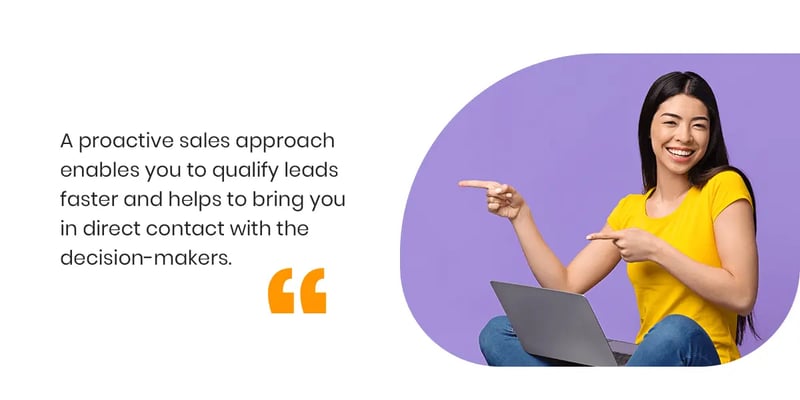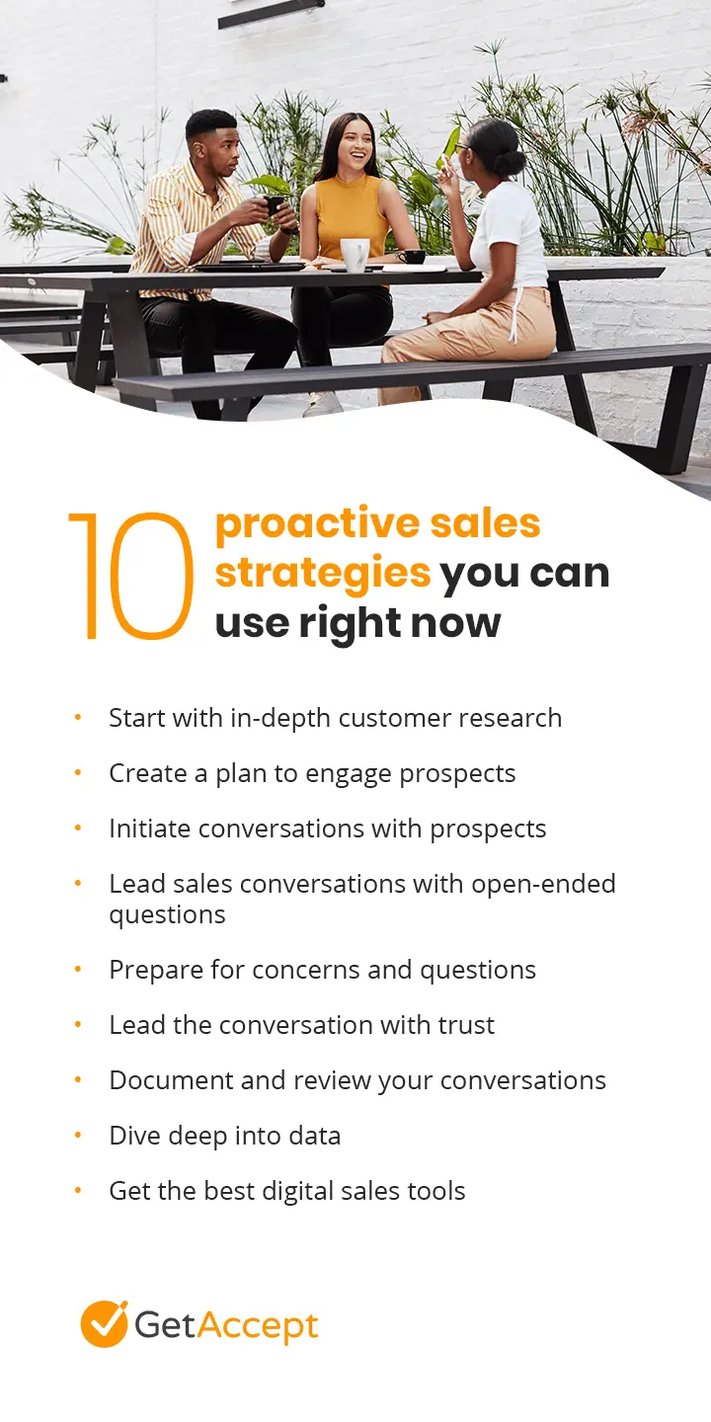Proactive selling can help your sales team effectively connect with more prospects and get them to buy your products or services faster.
In this article, you’ll learn what proactive selling is, how proactive selling compares to reactive selling, 10 proactive sales strategies you can employ right away, and the best tools that can empower your team to sell proactively.
Let’s dive in!
What is proactive selling?
First, let’s define proactive selling.
Proactive selling is a sales approach that actively identifies your prospects’ questions, pinpoints their problems, figures out their needs, and provides the necessary answers and solutions without waiting for the prospects to ask first — or even before they realize they have questions or need a particular solution or product.
What does proactive selling mean for your sales team?
This approach to selling empowers your sales team to always be ahead of the sales process and take control of the direction of every sales conversation.
What does proactive selling mean for your company?
Proactive selling puts the sales process in your hands, instead of leaving it for your prospects to control or decide. That’s not all. It shortens the duration of each sales life cycle and helps you close more deals faster.
Very good proactive selling examples include:
- Cold calling
- Cold emailing
- Social selling
The opposite of proactive selling is reactive selling. Next, let's look at what reactive selling is and how it compares with proactive selling for helping you close more deals and growing your bottom line.

Proactive vs. reactive selling
What is reactive selling?
Reactive selling is a sales approach that waits and responds to the prospects' questions, problems, needs, and wants, only when they realize and present them.
So between proactive and reactive selling, which will help your sales team get the best sales results? We compare proactive and reactive selling on five grounds.
Shorter sales life cycles
In proactive selling, the duration of each sales life cycle can be shorter than when your sales team adopts a reactive approach.
The reason is simple.
Because in proactive selling your sales team takes control of the sales process, they can control how fast the conversation goes. Compare this to reactive selling where your sales team always waits for the prospect to respond to messages, ask the questions, and make the demands.
That’s not all.
A proactive sales approach enables you to qualify leads faster and helps to bring you in direct contact with the decision-makers. Instead of lingering and working with the prospect's timing, taking charge of the conversation can help you get in front of the decision-makers faster.
Increased control of the sales process
Proactive selling gives you control of the sales process. Your sales team controls the pace and direction of the conversation.
What does this mean?
Your sales team can easily steer the conversation to the point of closing. On the reactive end, leaving the prospects to control the sales process might push them to your competitors and leave viable deals on the table.
More effective use of data
Because your sales team needs to know a lot about your prospects to be proactive, they can use data and projections to better serve them.
On the other hand, the reactive salesperson does not rely on data but on what the prospects request at a given point in time.
Increased speed of closing deals
Selling reactively means you always have to wait for the prospects to respond and make requests in their own time. This can extend the time it takes to close sales.
On the other hand, proactive salespeople are actively engaging the prospects, asking questions, and making the right recommendations for them. This approach can make the close faster and help you grow your revenue.
More strategic selling
Taking a proactive approach enables strategic selling and allows you to be prepared when dealing with prospects.
Here’s why.
To set the tone and pace for the conversation, you need to do your research to uncover the needs of your prospects. The findings from your research will enable you to lay out the best answers and solutions for your prospects.
On the other hand, reactive selling waits for the prospects to make all the requests and do all the asking. Little or no planning can be done here.
You’d agree that to close more deals, faster, your sales team would be better off selling proactively. Most sales teams prefer proactive selling for good reasons.

10 proactive sales strategies you can use right now
To help you to build a robust proactive sales and marketing system, here are 10 proactive sales strategies your sales team can use to close more deals today.
1. Start with in-depth customer research
You need to know your target customers' problems and needs more than they do.
To effectively help your target customers, answer their questions before they even ask and provide solutions to problems they haven’t realized they have. To do this, you'll need a deep understanding of their industry, the tools and vendors they work with, and where they are currently in their business.
You can start by studying your prospects on social media to understand the questions they ask, the brands they follow, what they talk about, and what their problem might be. You can also study their interaction with your brand to uncover the roadblocks they experience with your brand.
What will this help you achieve?
Deep research on your target customers will enable you to connect with them on an emotional level and create a plan for your sales conversations. It can also help you figure out the prospects who are not the ideal targets for your product.
2. Create a plan to engage prospects
Determine where you want the conversation to go and lead it there.
Whether you want the conversation to lead to a sale, getting connected with the decision-maker, or requesting a demo, a plan will help you lay out the steps you need to follow to get there.
Your plan may include the questions you have to ask, the offers you want to present to the prospects, the medium of communication you want to use, the content you want to share with the prospect, and more.
How will this help you be more proactive?
A core part of proactive sales is leading the conversation. Without a plan, you’ll be fighting fires, lack a clear direction, and exhaust your energy on things that wouldn’t help your business or your prospects.
3. Initiate conversations with prospects
Don’t wait for prospects to reach out to you. Take the lead.
Whatever sales enablement tools you use, and whether it’s a cold contact or a prospect who has been in contact with your company before, you need to take the lead and reach out to the prospect and not wait for them to reach out to you.
While this might be daunting at the beginning, it becomes easy as you do it more. Also, note that striking a conversation with your prospects is not the same as spamming them. There is a fine line between trying to help your prospects and trying to force sales.
How will striking conversations with prospects help your sales process?
It will give you control of the conversation — because you initiated it — and help you close more deals faster than if you sit and wait for them to reach out to you.
Tip: for selling SaaS products, try sending a tailored demo. It can be a simple video recording, or you can use an interactive demo creation tool like Walnut or Navattic. Letting prospects easily see the product without annoying qualification questions improves the buyer experience.
4. Lead sales conversations with open-ended questions
Your conversations should be like a constantly unraveling quest, not a straight jab to the wall.
Start and lead your sales conversation with open-ended questions. This will help you learn more about a prospects’ needs, objections, and questions. That’s not all. It will also enable you better position your product and power your future sales conversations.
The key to asking open-ended questions is simple. In your plan, try to avoid questions that demand straight "yes" and "no" as answers.
How will open-ended questions help your sales process?
It will make the conversation two-way — your prospects wouldn’t feel it’s a sales pitch but feel it’s a mutual discussion. Also, you’ll learn more about your prospects, so you can perfectly tailor your sales pitch to them.
5. Prepare for concerns and questions
Part of your planning is to anticipate leads' questions and objections and prepare for them.
For every question you ask, brainstorm all the possible objections and counter questions that your prospects will present and prepare answers for them. Also, it may serve you well to answer all their questions even before they ask.
How will this help your sales process?
Preparing and answering their questions and objections will break their wall of defense against your offer and prepare a level ground for them to consider your product.

6. Lead the conversation with trust
Make your conversation loaded with value.
Trust is the currency of today’s market. Your prospects want to ensure they can trust your brand. They want to know you can secure their interest before committing to you. If you can build trust early in your conversation, you can lay the path to closing the sale.
You can create value upfront and build trust in your brand by providing free advice, leading them to valuable content that can help answer their questions and solve their business problems by themselves, and providing them access to premium assets that may not be normally available.
How will this help you make a sale?
If your prospects can trust you early in the conversation, they may be more open to listening to you, responding to your messages and calls, and considering your products.
7. Document and review your conversations
Your conversation can be a source of data for future outreaches.
Record and document your conversations with your prospects. This could be in the form of taking notes, properly labeling and organizing your email conversations, sorting and organizing live chats, and recording your phone and video calls.
How will this help your sales process?
Documenting will provide more data for you and your team for future sales calls, help you understand a particular customer group, and serve them better with your product and offers. With this, you can make better data-driven decisions and refine your sales strategy, as well as understand your target customers better.
8. Dive deep into data
Use the data you gathered to understand and approach your prospects.
Whether it’s data you gathered from your interaction with your customers, data from your sales tools, CRM tools, or marketing analytics. Always use data to guide your conversations.
For example, your data may show that your point of first contact is not always the decision-maker. With this, you can start your next conversation with a request to speak with the key decision-maker or curate a list of content that can help your contact better communicate your offer with the decision-maker.
How will this help your sales process?
This will make your sales process faster, saving you time and resources. But to do this effectively, you need the best digital selling tool for your team.
9. Get the best digital sales tools
To sell proactively, you need tools that accelerate conversations with your prospects.
Using digital sales tools — for example, GetAccept — that allow your team to proactively reach out to customers and prospects, send SMS and chats, make video calls, and track engagement through well-structured analytics can help you and your team serve your prospects better and close more deals.
Get tips on how to utilize the full breadth of digital from Justin Bath, Sales Leaders at Algolia:
10. Request feedback consistently
Consistently request feedback from your prospects and colleagues
When you make a sale, ask your new customers what made them consider your product or services and what influenced their decision to buy. Also, when you do not make the sale, ask your prospects why they chose not to do business with you.
How will this help your sales process?
Gathering feedback will provide you useful insight into how your prospects think and what works in closing sales. This can greatly improve your chances of closing future deals.
Close more deals with GetAccept
There you have it, 10 strategies to help build a proactive sales and marketing framework.
Proactive selling can help you take control of the selling process and guide the direction of your sales conversations. While this may not be as easy as waiting for your prospects to reach out to you, it gives you the ability to warm up cold leads and harvest low-hanging hot leads fast.
If you follow the strategies in this article, your sales team will be prepared to get more deals close for your products and services.
To help salespeople connect with their customers and prospects better and faster, we built GetAccept. GetAccept is a sales enablement tool that allows you and your sales team to lead every sales conversation and proactively close more deals.
With GetAccept you can communicate with prospects and customers via chat, SMS, and video calls. You enjoy seamless and easy sharing of documents, automated smart reminders to bring prospects back to the conversation, e-signing of documents to eliminates tiring paperwork, smart notifications, advanced AI-powered analytics, and more.
This is what sales teams who use GetAccept to power their proactive sales strategy enjoy:
- 75% open rates for documents and content shared with prospects.
- Better and easier personalization of conversation.
- Easy integration with existing tools.
- Mobile and web applications to close more deals on the go.
- More deals and happy sales teams.
Want to see how GetAccept works for different use cases? Check out our customer case studies to see how we've helped companies around the world close more deals.




